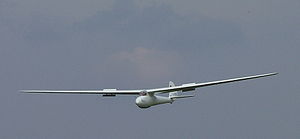- DFS Weihe
-
Weihe Role Glider National origin Germany Manufacturer Deutsche Forschungsanstalt für Segelflug (DFS)
Jacobs-Schweyer
Focke-WulfDesigner Hans Jacobs First flight 1938 Introduction 1938 Status No longer in production Produced 1938-after World War II Number built More than 400 The DFS 108 Weihe (English: Harrier) is a German single seat, high-wing, 18 metre wingspan, high performance glider that was designed by Hans Jacobs in 1937-38.[1][2]
Contents
Design and development
Jacobs designed the Weihe to be the pre-eminent performance glider of its era and indeed it captured many championships and set many records, until its performance was surpassed at the end of the 1950s. Even today it is considered one of the "classic sailplane designs".[1][2]
The Weihe is of wooden construction with aircraft fabric covering on the wing trailing edges and the control surfaces. The spar is built from Baltic Pine, with a birch leading edge D-cell, the fuselage and the fixed portions of the tail surfaces. The airfoil is a modified Gö 549-M.2 section. Early versions took off from a dolly and landed on a fixed skid, while later versions has a fixed wheel and skid undercarriage. Originally fitted with DFS-style airbrakes, some were later modified for Schempp-Hirth style brakes instead. The aircraft incorporates a unique rigging system which was widely copied in later gliders.[1][2]
Initially the aircraft was produced by Deutsche Forschungsanstalt für Segelflug (DFS) (English: German Research Institute for Soaring Flight) and later by Jacobs-Schweyer. Post World War II it was produced by Focke-Wulf as well as in France, Spain, Sweden and Yugoslavia. Production of the Weihe totaled over 400 aircraft.[1][2]
Operational history
The Weihe won the World Gliding Championships in 1948 and 1950. It was used to set many world and national records, including the world record for altitude gain in 1959 of 9,665 m (31,709 ft).[1][2]
Dick Johnson won the US National Soaring Championships in 1959, flying a Weihe.[2]
Variants
- DFS Weihe
- Original production version.[1][2]
- Jacobs-Schweyer Weihe
- Second production version, before World War Two. Had a larger canopy and longer nose.[1][2]
- Focke-Wulf Weihe 50
- Post war production version, with a free-blown canopy and a fixed wheel.[1][2]
- VMA-200 Milan
- Post war French production of the Weihe, by Minie, Saint-Cyr .[2]
- AB Flygindustri Se-104
- license production aircraft for the Royal Swedish Air force. 19 built.[citation needed]
Aircraft on display
- US Southwest Soaring Museum[3]
Specifications (Weihe)
Data from Sailplane Directory and Soaring Magazine[1][2]
General characteristics
- Crew: one
- Wingspan: 59 ft 1 in (18.0 m)
- Wing area: 198 sq ft (18.4 m2)
- Aspect ratio: 17.6
- Airfoil: modified Gö 549-M.2
- Empty weight: 508 lb (230 kg)
- Gross weight: 738 lb (335 kg)
Performance
- Maximum glide ratio: 29:1 at 47 mph
- Rate of sink: 120 ft/min (0.61 m/s) at 40 mph
- Wing loading: 3.7 lb/sq ft (18 kg/m²)
See also
- Related lists
References
- ^ a b c d e f g h i Activate Media (2006). "Weihe Jacobs Schweyer". http://www.sailplanedirectory.com/PlaneDetails.cfm?PlaneID=380. Retrieved 27 February 2011.
- ^ a b c d e f g h i j k Said, Bob: 1983 Sailplane Directory, Soaring Magazine, page 74. Soaring Society of America, November 1983. USPS 499-920
- ^ US Southwest Soaring Museum (2010). "Sailplanes, Hang Gliders & Motor Gliders". http://swsoaringmuseum.org/collection.htm. Retrieved 26 May 2011.
External links
Aircraft produced by the Deutsche Forschungsanstalt für Segelflug Lists relating to aviation General Aircraft (manufacturers) · Aircraft engines (manufacturers) · Airlines (defunct) · Airports · Civil authorities · Museums · Registration prefixes · Rotorcraft (manufacturers) · TimelineMilitary Accidents/incidents Records Categories:- German sailplanes 1930–1939
Wikimedia Foundation. 2010.

